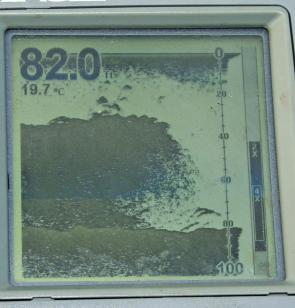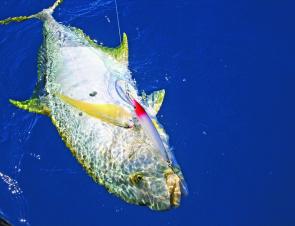Dragging big, deep diving minnow lures over offshore reefs and wrecks is an exciting and productive way to fish, but few anglers really make the most of this tactic.
With the current focus on soft plastics, jigs and blades, I guess it’s fair to say that trolling hard-bodied minnow lures has become one of the most under-rated techniques in the offshore angler’s arsenal. That’s pretty sad because in the right place and at the right time, trolling with minnow lures can be highly effective. It can also be a fun and physically challenging way to put together a nice feed of fish without the need to spend a fortune on the latest tackle and equipment.
While there are plenty of different ways to approach lure trolling in general, this article will concentrate on what I consider to be the most exciting and exacting aspects of the sport and that’s towing big, ultra deep diving minnow lures. I love this type of fishing because you can never be sure what’s going to grab your lure next. Out over the reefs and wrecks, it can become a real ‘lucky dip’ of species with everything from mackerel to even marlin being a real possibility.
The other reason I particularly enjoy trolling with ultra-deep diving lures is that once you get the hang of it, it can be a very precise way of targeting your quarry. With the latest sounders and GPS units, it’s possible to almost zero in one specific target, and then deploy lures that will run at just the right depth to be intercepted by the feeding fish. It also tends to be a good way of picking out the larger predators from the school, as the frantic beating action of a big minnow lure nearly always seems to draw the biggest and brashest predators in for the kill.
Before getting into the specifics of this approach, I suppose I’d better explain what I mean by deep diving lures. While most minnow lures dive to some degree, I don’t think you can really call them deep divers until they run somewhere around the five metre mark. To qualify as a really deep diver however, I think it’s fair to say that the lure should push down somewhere around 7-10m, as this is where things often really start to get interesting. Luckily these days there are a surprising number of big minnow lures with this sort of capability. In fact, there are even some lures which can run a lot deeper than this, but 7-10m divers will be get the most use.
In terms of size, I generally follow the old ‘bigger is better’ idea. As mentioned before, the bigger the lure, the more flash and vibration it puts out and the better the predators seem to like it. Of course, there is an upper limit to what you can realistically troll on ‘normal’ fishing gear, but lures of 15-30cm are pretty standard fare. Think Rapala X-rap Magnum 30 and 190mm Halco Laser Pros and you will have a pretty good idea of the sort of lures I’m talking about.
Interestingly, having tried a few lures that are a fair bit bigger than the ones I’ve just listed, they don’t seem to produce fish all that much bigger than we get on our usual lures. As really big minnows are a lot more expensive to buy and generally require a lot more effort to troll, I rarely bother to use them. Mind you, I generally take at least one really big banger out with me on each trip, just in case.
While most people see trolling as a pretty laid back way to fish, the way we do it is actually quite a precise and active technique. We generally employ quite short trolling runs and target specific structure or bait and predators identified by our electronics. If the fish are cooperative then there is rarely time to put a rod in the holder. This is probably a good thing anyway, as the explosive belt of a big pelagic colliding with a fast moving minnow lure is one of those moments that you’ve just got to be holding the rod to experience properly.
The first step in the whole process is to find something to target with your lures. In our local area, we mainly fish around sunken wrecks, but any significant structure holding good schools of baitfish should be worth a look. A lot of our fishing is done in water between 25-30m deep and while we generally can’t get our lures to the bottom, the fish generally hold and feed well off the bottom anyway.
As most of the action happens well below the surface, the ability to accurately interpret what your depth sounder is showing you is an important skill to master. I’d have to say that good quality marine electronics and having the absolute confidence in what they are showing can really make or break a trip. When I’m trolling deep divers, I spend nearly all my time staring at the sounder screen, watching for any clues as to where the bait fish are holding, where the predators are hanging and how active they may be. Believe it or not, once you’ve had a bit of practice, the shape and density of the bait school and the location of predators can give you a very accurate understanding on what’s going on down there. After a while you can pretty much call strikes, even before they happen.
Once you’ve got your lures sorted, feeling confident in your ability to read your sounder and have selected a likely place to troll, you need a general plan of attack to help you put it all together. While different locations will always require slightly different approaches, we have a general game plan we employ and it seems to be a fairly consistent way to go about it.
On arriving at our chosen fishing location, the first thing I do is drop a couple of lures out the back and spend a bit of time looking around. If it’s early in the morning, I’ll often start with some large, shallow running lures like Reidy’s Big Ass B52s, as active hunters like mackerel are often up and feeding in the surface layers before the sun gets too high in the sky. At other times, I go with one medium deep and one ultra deep diver, to see if we can’t find where the fish are feeding in the water column. The time spent in the initial search pattern is about the only random part of the whole trolling process. What we are actually trying to do whilst looking around, is to further narrow down productive areas to find the prime pieces of structure and/or locate where the bait schools are holding, as these can and do move around a bit from trip to trip and even during the course of a day’s fishing.
Each time I find a school of bait, see something interesting on the sounder or get a strike on one of the lures, I punch in a waypoint on the GPS. Before long, I’ve built up a pretty good picture of what’s happening beneath us, so I then set up short trolling runs which take us over the most likely looking spots. This way, we can maximize our fishing time and know our lures are spending the majority of their time where they are likely to get eaten.
The lures we actually use really depend on what we see on the sounder. The deeper the bait and predators are holding, the deeper your lures need to run. It’s worth remembering that most fish have their eyes located towards the top of their heads and are used to looking up for a feed. This means they will often swim up to intercept a lure, but I don’t think they will dive down as freely to do the same thing. Having said that, sometimes, it’s only the deepest divers that will pull the fish, so if you are confident there are fish beneath you, make sure you pick lures that will get down as to close to the fish as possible.
One thing I have noticed is that you don’t need to troll as fast with really deep diving lures as you would with shallow running lures. I’m not sure why that is exactly but anything from a fast walking pace up to five or six knots is generally sufficient. You will need to let the lures out a fair way behind the boat however, as they need a little bit of extra line to help them reach their true running depth. Speaking of which, thin braided lines are also a help, as they allow the lures to run that little bit deeper because of their ability to create less drag.
One final tip I’d like to leave you with concerns those exciting few seconds after you get a strike. Once you do hook up, it pays to continue trolling for another 10-20 seconds or so, as that will often generate a strike from another fish in the same school. You can often turn a single hook-up into a double as the competitive nature of these fish takes over.
So there you go. Don’t overlook trolling as a technique the next time you head offshore. Grab some deep diving minnows and try dragging them around your favourite fishing location. If all goes to plan, you should soon find yourself getting smashed and stretched by some serious fish.
Facts
Target Species
Trevally (Goldens, Giants, Bludgers, Diamonds)
Spanish Mackerel
Tuna
Cobia
Marlin
Queenfish
Facts
Recommended Lures
Rapala XRap Magnum 30 and 20
Halco Crazy Deep Scorpions and 190mm Laser Pros
Sebile Long Lip minnows.
Oargee Oarsomes (new high speed models)
Facts
Gear Box
| Rod: | Short Rod around 5’6” |
|---|---|
| Reel: | Medium-sized overheads or spinning reels 7000 size and up |
| Line: | 300m of 10-15kg braid |
| Leader: | 24-30kg mono |

The author’s son Matthew Magner with a typical golden trevally trolled offshore from Bundaberg.

This manageable GT scoffed an X-Rap 30 as it was trolled over a submerged wreck.

Here’s what you are looking for on the sounder. This is a serious bait school and check out those scary arches hanging off the side. We pulled some nice fish out of this patch.

Here’s a collection of serious deep trolling tools. Rapalas, Halcos and a Sebile. All carry decent hardware and can handle the punishment they are surely going to get.

While goldens are often thought of as a shallow water species, they love to school over deep structure where you can target them with big minnow lures.

Whatever lures you use, they will need to be tough enough to stand up to strong jaws and sharp teeth. This was just one hookup and even though the fish was landed, it tested the terminal tackle to the limit.





